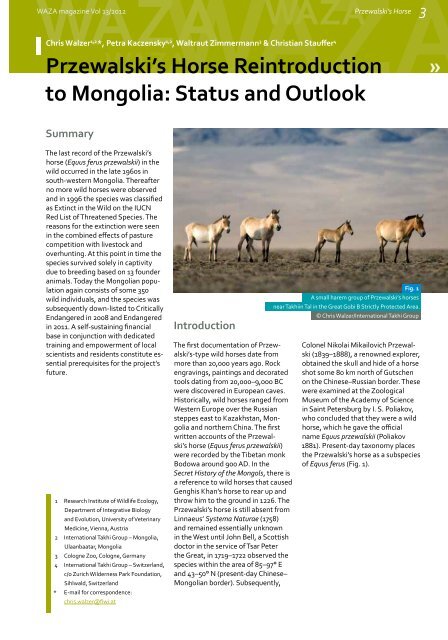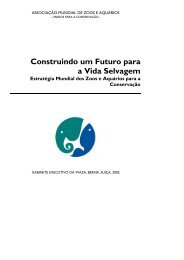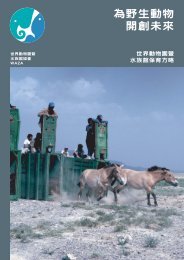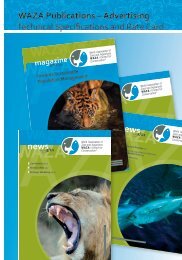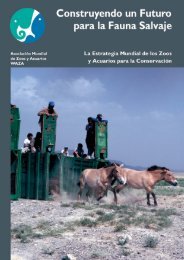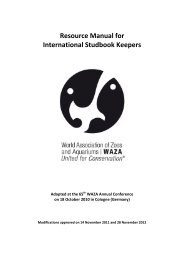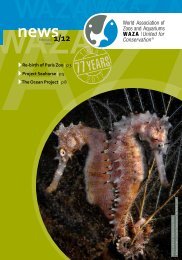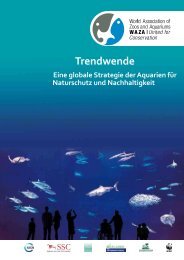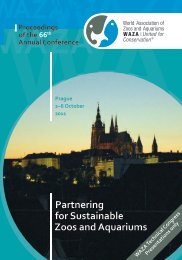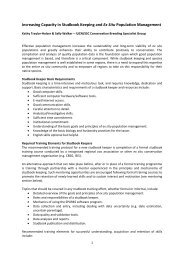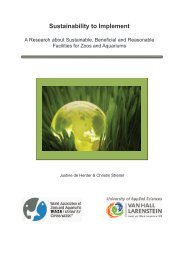Fighting Extinction - Waza
Fighting Extinction - Waza
Fighting Extinction - Waza
You also want an ePaper? Increase the reach of your titles
YUMPU automatically turns print PDFs into web optimized ePapers that Google loves.
WAZA magazine Vol 13/2012<br />
Chris Walzer 1,2 *, Petra Kaczensky 1,2 , Waltraut Zimmermann 3 & Christian Stauffer 4<br />
Przewalski’s Horse<br />
Przewalski’s Horse Reintroduction<br />
to Mongolia: Status and Outlook<br />
Summary<br />
The last record of the Przewalski’s<br />
horse (Equus ferus przewalskii) in the<br />
wild occurred in the late 1960s in<br />
south-western Mongolia. Thereafter<br />
no more wild horses were observed<br />
and in 1996 the species was classified<br />
as Extinct in the Wild on the IUCN<br />
Red List of Threatened Species. The<br />
reasons for the extinction were seen<br />
in the combined effects of pasture<br />
competition with livestock and<br />
overhunting. At this point in time the<br />
species survived solely in captivity<br />
due to breeding based on 13 founder<br />
animals. Today the Mongolian population<br />
again consists of some 350<br />
wild individuals, and the species was<br />
subsequently down-listed to Critically<br />
Endangered in 2008 and Endangered<br />
in 2011. A self-sustaining financial<br />
base in conjunction with dedicated<br />
training and empowerment of local<br />
scientists and residents constitute essential<br />
prerequisites for the project’s<br />
future.<br />
1 Research Institute of Wildlife Ecology,<br />
Department of Integrative Biology<br />
and Evolution, University of Veterinary<br />
Medicine, Vienna, Austria<br />
2 International Takhi Group – Mongolia,<br />
Ulaanbaatar, Mongolia<br />
3 Cologne Zoo, Cologne, Germany<br />
4 International Takhi Group – Switzerland,<br />
c/o Zurich Wilderness Park Foundation,<br />
Sihlwald, Switzerland<br />
* E-mail for correspondence:<br />
chris.walzer@fiwi.at<br />
Introduction<br />
The first documentation of Przewalski’s-type<br />
wild horses date from<br />
more than 20,000 years ago. Rock<br />
engravings, paintings and decorated<br />
tools dating from 20,000–9,000 BC<br />
were discovered in European caves.<br />
Historically, wild horses ranged from<br />
Western Europe over the Russian<br />
steppes east to Kazakhstan, Mongolia<br />
and northern China. The first<br />
written accounts of the Przewalski’s<br />
horse (Equus ferus przewalskii)<br />
were recorded by the Tibetan monk<br />
Bodowa around 900 AD. In the<br />
Secret History of the Mongols, there is<br />
a reference to wild horses that caused<br />
Genghis Khan’s horse to rear up and<br />
throw him to the ground in 1226. The<br />
Przewalski’s horse is still absent from<br />
Linnaeus’ Systema Naturae (1758)<br />
and remained essentially unknown<br />
in the West until John Bell, a Scottish<br />
doctor in the service of Tsar Peter<br />
the Great, in 1719–1722 observed the<br />
species within the area of 85–97° E<br />
and 43–50° N (present-day Chinese–<br />
Mongolian border). Subsequently,<br />
Fig. 1<br />
A small harem group of Przewalski’s horses<br />
near Takhiin Tal in the Great Gobi B Strictly Protected Area.<br />
© Chris Walzer/International Takhi Group<br />
Colonel Nikolai Mikailovich Przewalski<br />
(1839–1888), a renowned explorer,<br />
obtained the skull and hide of a horse<br />
shot some 80 km north of Gutschen<br />
on the Chinese–Russian border. These<br />
were examined at the Zoological<br />
Museum of the Academy of Science<br />
in Saint Petersburg by I. S. Poliakov,<br />
who concluded that they were a wild<br />
horse, which he gave the official<br />
name Equus przewalskii (Poliakov<br />
1881). Present-day taxonomy places<br />
the Przewalski’s horse as a subspecies<br />
of Equus ferus (Fig. 1).<br />
3<br />
»


